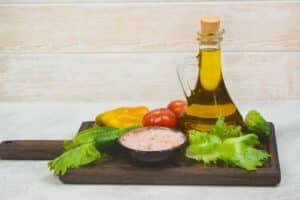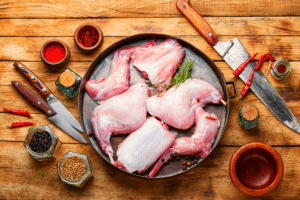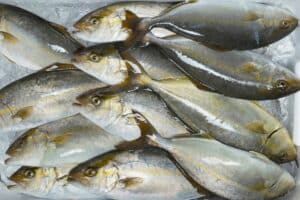Thailand is full of wonderful, delicious food – but what spices do they typically use in their cooking? Anyone who has ever tried to replicate a Thai dish will know that some of the ingredients used are not your run-of-the-mill stuff.

No, these ingredients are packed full of flavor, and not always the easiest to find. However, if you know where to look, you may be able to get your hands on them! Before you can do that, though, you need to know what you are looking for.
Truth is, there are lots of important ingredients in Thai cuisine. Some of the most popular options include things like cloves, coriander powder, chili flakes, Thai ginger, and makrut lime leaves. That, however, is only the tip of the iceberg.
If you want to find out more about Thai cooking and those all-important spices that you absolutely need in your kitchen, keep reading! We will cover everything you need to know right here.
What Exactly Are Thai Spices?
There’s no real answer to this because Thai spices vary greatly! In some cases, particular Thai species might be used to create a Thai blend, but this will also vary from dish to dish.
The spices used in Thai cooking (please note: we are using the term ‘spices’ very broadly here) add lots of flavor to the dish, and usually a punch of heat, too.
When flavors are used together, depth is added to the dish to make it more complex and mouthwatering good. Many of them can even be used for both savory and sweet dishes, depending on taste!
Is It Normal For Thai Food To Be So Spicy?
In short – yes! However, not all Thai food is spicy by any means. Their cuisine is very broad, and there are plenty of non-spicy dishes that you can enjoy if you are not a fan of spices. With that being said, you should never expect Thai food to be bland.
Their food will always be packed full of delicious flavor, and flavor does not always mean spice. It’s worth noting that chilies are frequently used in Thai cooking.
Like the point above, it’s important to remember that not all chilies are actually hot! Some have a sweet flavor, while others will burn your taste buds off.
Where Can You Find Thai Spices?
Luckily, you can usually find most Thai spices with relative ease. If you like to order online, you can head to places like Amazon or a specific Thai spice retailer.
However, if you don’t mind leaving the house, you could get lucky and find most of what you need in your regular grocery store. In some cases, you might need to seek out your local Asian grocery store or market.
If you know of a local store (online or in-shop), you should check them out and see what they have! More often than not, these stores have everything you could ask for.
Which Spices Are Usually Used In Pad Thai?
There are no set spices for pad Thai since there are so many recipes out there. However, there are some common ingredients that show up in recipes time and time again. So, if you were going to make this dish, you can expect to add the following ingredients at some point:
- Sugar
- Fish sauce
- Chili pepper (or flakes)
- Ginger
- Garlic
- Tamarind paste
- Thai basil
You would be hard-pressed to find a pad Thai recipe that doesn’t call for these (but that doesn’t mean that it doesn’t exist).
15 Of The Best Thai Spices You Need To Use In Your Cooking
Now that you know all the basics about Thai spices and ingredients, we can jump into some of the most popular Thai spices that you need to get in your kitchen.
Remember – we’re using the term ‘spice’ very loosely here! These are all simple ingredients that will give your dish some delightful flavor.
1. Kaffir Lime (Makrut Lime Leaves)
These lime leaves have a wonderful peppery and citrusy flavor, making them perfect for adding to stir-fries, soups, and of course, curries! They are also used for making green curry paste (along with many other ingredients).
If you ever have the pleasure of trying Thai iced tea, you will quickly notice that these lime leaves are also used there, too. You could probably find a hundred other uses for them if you tried!
2. Pak Chee (Cilantro Or Coriander Powder)
Some people love cilantro, others absolutely hate it. However, there is no denying that this ingredient plays a key role in Thai cooking. Coriander powder is a spice that comes from the coriander plant, and it tends to have a very fragrant and citrusy flavor.
It can be used in savory and sweet dishes if you know what you’re doing! You will find coriander powder, and even fresh coriander, in a variety of dishes around the world.
In Thailand, you will get to enjoy it in various soups like tom yum, pad Thai, and curries like massaman, red, and green curry.
3. P̄hng Yī̀h̄r̀ā (Cumin)
Cumin is another popular ingredient that you are likely already aware of. Cumin has fantastic and complex flavors that immediately add depth to a dish. The flavor is warm and earthy, with a strong aroma that you cannot mistake.
What’s even better about this ingredient is that it is full of helpful vitamins and minerals, including magnesium, manganese, and iron! So, you can enjoy it and know you’re getting something good out of it.
4. Mĕd Yī̀h̄r̀ā (Fennel)
This aromatic spice is used in many different cuisines, including Thai! It has a potent licorice-like flavor and is used in a variety of dishes like soups and curries. Fennel is especially popular in poultry dishes but is also used in fish and vegetable recipes, too.
It’s important to note that Thai fennel is not the same thing as European fennel. Thai fennel has a more robust aniseed flavor and can be purchased fried or fresh in just about any Thai supermarket or store.
5. ฟีนูกรีก (Fenugreek)
Fenugreek is also used in lots of recipes around Asia. This ingredient is known for its unique and pleasant flavor and is often served in things like curries to add extra depth.
It is also possibly linked to a number of health benefits, including helping to control blood sugar levels and aiding in digestion. So, if this is an ingredient that you are not using yet, you may want to get your hands on it!
6. Krawaan (Cardamom)
Cardamom is a fantastic source of antioxidants and is known for its anti-inflammatory properties. However, it is also a wonderfully aromatic spice that can be used in a variety of ways in cooking. The earthy and pungent aroma of this spice.
It is versatile and can be used in curries and soups, but also in baking. It’s common for cardamom to be used in cheesecake recipes, as well as bread pudding and cookies, as it adds some lovely warmth to the dish.
7. Kānphlū (Cloves)
If you want an ingredient that will add some spice and warmth to any dish – sweet or savory – cloves will be your go-to.
Not only do gloves have some fantastic health benefits like having anti-inflammatory properties and aiding with digestion, but they truly taste fantastic. Cloves can be ground into a powder of used fresh, and have a nice sweetness to them with a slightly bitter undertone.
You may already be used to seeing cloves being used in marinades and meat rubs, but are also frequently used in baked goods.
8. Phrikthịy (Peppercorns)
Peppercorns have a potent peppery and spicy taste that many of you will already be aware of. They can help with digestion and also stimulate the appetite! This ingredient is frequently used in meat-based curries and various stir-fries to add some extra depth to the dish.
You will often find peppercorns in stews and soups, as well as marinades and sauces. However, thanks to their potent flavor, they can also work well in baked goods and sauces.
9. Pó Ykạ́k (Star Anise)
Used either whole or ground, star anise is another ingredient that you can enjoy in both sweet and savory dishes.
This spice is thought to have a number of health benefits such as fighting against infection and improving gut health, and has long since been used as a medicinal herb. Its flavor is licorice-like and pleasantly sweet, but not overpowering.
Most recipes that use star anise also use ingredients like cloves, cinnamon, and black pepper to create a robust and deep flavor profile. Not only is it tasty and medically useful, but star anise contains high levels of vitamins B6 and C, as well as iron and manganese!
10. Galangal (Thai Ginger)
This rhizome is frequently used in Thai cooking to add flavor and depth to any dish. It is primarily used in curries and has a peppery, woody flavor that goes well with everything. This ginger is different from the regular ginger you may be used to.
Galangal is much harder than regular ginger and must be sliced as it cannot be grated. Like many ingredients on this list, Thai ginger has a number of potential health benefits, which include reducing inflammation and aiding digestion. So, it’s tasty and beneficial!
11. Kratheīym (Garlic)
We don’t need to go into too much detail here – the vast majority of people will already be familiar with garlic and its many wonderful uses. It has a strong and pleasant flavor, especially when cooked, and is used for a variety of savory dishes – including curries and soups.
Garlic may be associated with lowering blood pressure as well as reducing the risk of heart disease. It is common for both garlic powder and fresh garlic to be used in stir-fries, while fresh garlic is predominantly used in curries.
12. Prik Bon (Chili Powder Or Chili Flakes)
Again, many people will be familiar with this for day-to-day cooking. Chili flakes are popular in many Asian cuisines (and for good reason), and chili powder is right alongside it.
These two ingredients, while they have slightly different tastes, work well to add some heat and flavor to a dish.
This is one of the key ingredients in Thai cooking, so don’t think that you can overlook it! This, paired with ginger, garlic, and lemongrass is the most important ingredient in this cuisine.
13. Mạs̄tār̒d (Mustard)
Mustard can be used to add some heat and depth to a variety of dishes. It has a potent aroma and is known for having a number of health benefits including aiding in digestion. It is also high in antioxidants.
In Thai cooking, mustard seeds are frequently fried or roasted, or even soaked in water before being used in recipes. A number of curry recipes call for mustard seeds.
14. Lūk Cạnthn̒theṣ̄ (Nutmeg)
Nutmeg is even more popular in Thai cuisine than it is in places like the US! This ingredient has a very pleasant and warm, nutty flavor, and is used in both sweet and savory dishes.
It is thought to be beneficial to health in aiding digestion, so you can enjoy this guilt-free. It is common for nutmeg to be freshly ground with a pestle and mortar before being added to a dish, where it will add some fantastic flavor and depth.
15. Takrai (Lemongrass)
Finally, lemongrass is a crucial ingredient in Thai cooking! This refreshing and citrusy ingredient adds lots of flavor to any dish and can be used for sweet and savory recipes, too.
You will notice that the majority of Thai curry recipes incorporate lemongrass in the dish. Without this crucial ingredient, no Thai curry would be the same.
Final Thoughts
Thai cuisine uses plenty of fantastic herbs and spices. They all add wonderful flavor and depth to dishes and make the taste more complex and enjoyable.
If you don’t have these ingredients in your kitchen, we would strongly urge you to change that. You could be missing out on a whole new world of cuisine that you will fall in love with!






